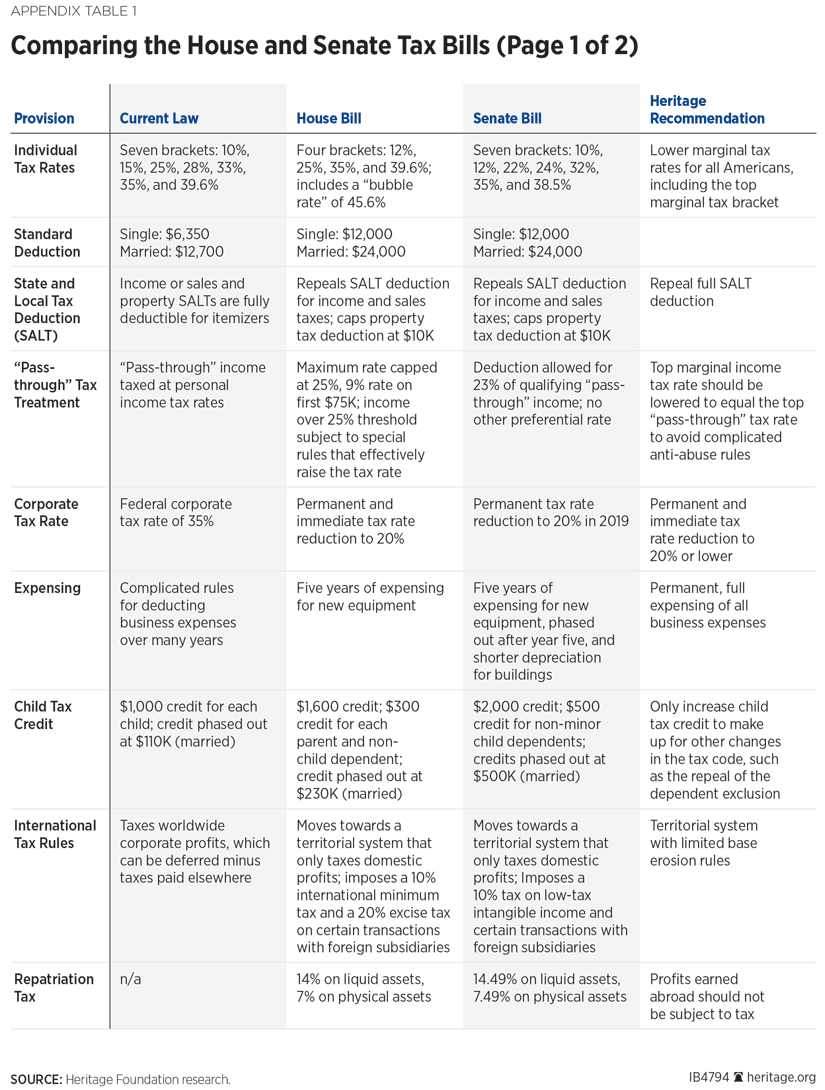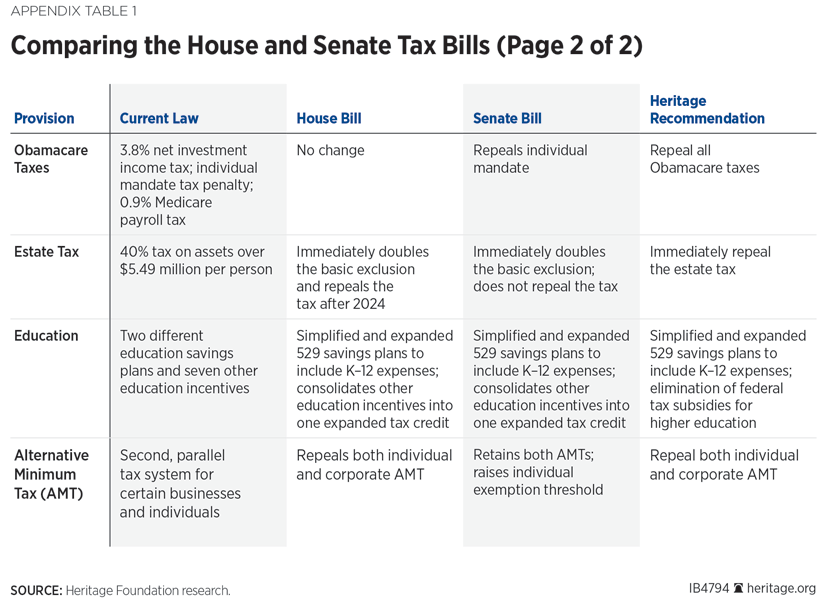The House and Senate each passed slightly different versions of the Tax Cuts and Jobs Act. The two versions now head to a conference committee where select lawmakers from both chambers will work towards one unified bill.[REF]
A conference committee gives Congress the opportunity to make further improvements to the bills. However, conference comes with the danger that they could weaken the final legislative package.
Given the differences, there are certain components of each bill that should be included in a final package. The major differences between the bills are included in the appendix.
The conference committee should begin with the Senate-passed bill because the political balance struck in the Senate will be important to maintain for final passage. The House bill, however, has many worthy provisions that will make the Senate bill even stronger.
The Best Parts of the House and Senate Plans
1. 20 Percent Corporate Tax Rate and Expensing. In both bills the corporate tax rate is cut from 35 percent—one of the highest rates in the world—to 20 percent. A 20 percent federal corporate tax rate is the upper bound for global tax competitiveness.[REF] The conference report should implement the 20 percent rate immediately, as in the House bill, rather than delaying it by one year, as the Senate bill would do.
All businesses will also be able to immediately write off the costs of new equipment for five years. This provision, called “expensing,” removes a current tax bias against investment.[REF] The Senate improves on the House bill by reducing the tax penalty against investing in buildings and further extends partial expensing of equipment beyond five years.
In an ideal world, immediate expensing should be permanent and afforded to all business purchases, not just used to favor new equipment. This is an area that Congress should return to in future legislation.
2. Elimination of Tax Subsidies. Both the House and the Senate bills eliminate the state and local tax deduction for income and sales tax and cap the property tax write-off at $10,000. This true structural reform will increase the efficiency and fairness of the entire U.S. tax system.
Removing the state and local tax deduction ends the current economically destructive subsidy whereby similar taxpayers in low-tax states pay higher federal taxes than those in high-tax states. The deduction subsidizes big government and high-income taxpayers at the expense of the rest of Americans.[REF]
The larger standard deduction is a tax simplification, and goes a long way towards limiting the value of tax subsidies in the form of itemized deductions for individuals.[REF] Both the House and the Senate bills eliminate a current subsidy to domestic manufacturing in favor of lower rates for all businesses types.
The House bill goes even further on subsidies elimination than does the Senate bill. The conference report should favor removing as many tax subsidies and privileges as possible and focus on lowering rates with the savings. In this area, then, the conference committee should default to the House bill. The House bill, among other things, caps the mortgage interest deduction for future home buyers; repeals the deductions for medical expenses, private activity bonds, and student loan interest; and eliminates credits for historic rehabilitation, energy production, orphan drugs, and “new-market” investments, among others.
3. Individual Mandate Repeal. The conference committee should include the Senate’s repeal of Obamacare’s individual mandate. Zeroing out the tax, which forces individuals to buy health insurance, would provide tax relief to millions of Americans who cannot afford the rising costs of Obamacare insurance.
Repealing the mandate would put anywhere between $695 and $13,100 back into the pockets of American families, if they choose to not purchase the type of health insurance that Obamacare requires.[REF]
4. Education Savings Accounts Expansion and Tax Credits Simplification. The House bill includes two important simplifications to education policy that are largely left out of the Senate reform. The House consolidates seven different education tax incentives into the existing American opportunity tax credit and makes it available for an additional year.[REF]
The House bill allows K–12 education expenses to be eligible for a 529 college savings account, increasing the ability of parents to pay for education options outside the public school system.[REF] The plan consolidates the current two savings programs (Coverdell accounts and 529 plans) into a more flexible and more broadly available version of the current 529 college savings plan, allowing the plans to be used for elementary and secondary education expenses. The House version would also allow 529 savings to be spent on apprenticeship programs, enabling students to save for post-secondary options other than college tuition.
The Senate version of the proposal would also expand the plans to homeschooling expenses.[REF] This modification should be included along with the rest of the House education reforms.
Room for Improvement
1. Individual Tax Rates. Neither the House nor the Senate lower personal taxes as far as they should. The House plan consolidates the number of tax brackets from the current seven down to four, but does not lower the current top tax bracket of 39.6 percent. The plan actually raises marginal rates on some taxpayers making over $200,000 and includes a new “bubble tax rate” of 45.6 percent for some high-income earners.
The Senate bill improves the House bill by lowering marginal income tax rates for a larger share of Americans. Lower marginal rates are important, but rates can still come down further to fully compensate many upper-middle-class taxpayers who will be impacted by other changes in the tax code. The goal of tax reform should be lower taxes for every American.
Lowering tax rates further will be difficult within the constraints of the Senate budget rules. However, reform should strive to lower rates for every income level and as many individual taxpayers as possible. If lower rates are not possible this year, Congress should return to these issues in future legislation.
2. Business Deductions. In response to concerns that small and pass-through businesses did not receive a big enough tax cut in the original Senate bill—a dubious claim—the Senate expanded the business deduction from 17.4 percent to 23 percent.[REF]
Such a large business deduction increases the incentives to artificially treat income from wages as business income. The House bill addressed this problem with anti-abuse rules that are arbitrary, complicated, and unfair to certain types of businesses. However, the rules limit the problem the Senate bill now faces by creating a subjective and loophole-riddled system. The Senate bill denies the business deduction to certain service industries above a $500,000 threshold.
Because of its relative simplicity, the Senate pass-through treatment is still preferable to that of the House. However, Congress should focus first on lowering the top marginal tax rate to 35 percent as originally proposed, rather than creating a new preference for certain business income.
Outstanding Problems in Need of Solutions
1. Repeal the Alternative Minimum Tax. The House bill rightly eliminates the alternative minimum tax (AMT) in both the corporate and individual tax codes. The Senate bill retains both AMTs and raises the threshold where the tax kicks in for individuals.
The AMT generally applies an alternative tax rate to a more broadly defined measure of income and allows a narrower set of deductions. The provision increases the tax liability for those firms and individuals who can uniquely lower their effective tax rate by taking advantage of the normal tax system.
Under the Senate plan, the AMT becomes the new default corporate tax base because the rate remains at 20 percent. This effectively eliminates expensing (one of the most pro-growth components of the plan), limits other cost-recovery allowances, and cuts into other provisions like the research and development tax credit and the low-income housing credit.[REF] Lawmakers should trade the final removal of the AMT for the elimination of all business tax credits, including those that are politically popular, such as R&D and housing subsidies. This should allow everyone’s taxes to be lowered.
Tax reform that fixes the primary tax system, as the Tax Cuts and Jobs Act does, makes the AMT an even more unnecessary and burdensome appendage. The current AMT does its intended job poorly, burdens taxpayers unduly with additional paperwork, and unfairly uses different treatments for similar taxpayers. Repealing the AMT is an important part of tax reform.
2. Repeal the Estate Tax. The Senate, like the House, doubles the basic exclusion for the estate tax from its current $5.49 million per person. The Senate, however, never fully repeals the death tax.
Not permanently repealing the death tax is economic malpractice, as it would forgo potential economic growth and likely make fully repealing the tax more difficult later on when those affected by it will be an even smaller minority of Americans.[REF]
3. Make Good Tax Policy Permanent. Due to Senate budget rules, the Senate reforms have many temporary provisions for both individuals and businesses. Tax policy should not be temporary, but instead should strive to provide certainty for taxpayers, now and in the future. Political realities of the Senate budget process mean that many provisions will remain temporary.
The good news is that these expirations give Congress the opportunity to revisit the tax code in the coming years and finish the work they are just now beginning. Congress can further cut taxes for individuals and extend and make permanent any temporary provisions.
Locating the Revenue
If Congress indeed wants to combine the best components of the two tax bills, there are many options for meeting the constraints of the Senate budget rules. In the pursuit of fairer and less complex tax policy, there are about $400 billion worth of tax preferences repealed in the House proposal that the Senate does not repeal. In addition to the items that have already been proposed, repealing the remaining business tax credits and repealing the deduction for municipal bond interest could free up an additional $500 billion of room to cut taxes further.
—Adam N. Michel is a Policy Analyst in Tax and Budget Policy in the Thomas A. Roe Institute for Economic Policy Studies, of the Institute for Economic Freedom, at The Heritage Foundation.
Appendix




